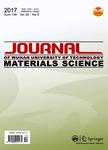Hydrothermal Synthesis of Zn2SnO4/Few-Layer Boron Nitride Nanosheets Hybrids as a Visible-Light-Driven Photocatalyst
Hydrothermal Synthesis of Zn2SnO4/Few-Layer Boron Nitride Nanosheets Hybrids as a Visible-Light-Driven Photocatalyst作者机构:School of Materials Science and EngineeringHebei Provincial Key Laboratory of Traffic Engineering MaterialsShijiazhuang Tiedao University
出 版 物:《Journal of Wuhan University of Technology(Materials Science)》 (武汉理工大学学报(材料科学英文版))
年 卷 期:2019年第34卷第3期
页 面:563-567页
核心收录:
学科分类:08[工学] 0805[工学-材料科学与工程(可授工学、理学学位)] 0702[理学-物理学]
基 金:Funded by Natural Science Foundation of Hebei Province China(No.E2013210011)
主 题:zinc stannate boron nitride nanosheets photocatalysis
摘 要:Zn2SnO4/few-layer boron nitride nanosheets (FBNNS) hybrids were synthesized via a one-step hydrothermal method. The structures, morphology, optical properties, electron transformation and separation of the as-prepared products were characterized by X-ray diffraction, transmission electrical microscopy, UV-vis diffuse reflectance spectroscopy and electrochemical impedance spectroscopy, respectively. Rhodamine B was used to evaluate the photocatalytic activities of the as-prepared samples under visible light illumination. The photocatalytic mechanism was also explored. Experimental results showed that the degradation efficiency of rhodamine B was firstly increased and then decreased with increasing the usage amount of FBNNS. When it was 9 wt% based on the weight of Zn2SnO4, the degradation efficiency of the as-prepared Zn2SnO4/FBNNS-9 wt% composites reached to the maximum of 97.5 % in 180 min, which was higher than 39.2 % of pure Zn2SnO4. Moreover, the holes played mainly active roles in photocatalytic reaction process. In addition, the as-prepared hybrids could enhance the separation efficiency of photoexcited carriers compared to pure Zn2SnO4.



